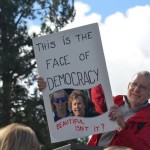SAN MARCOS — They came by foot, train and autos, most clad in pink hats with cat ears on them and carrying signs with a broad range of messages from human rights, to women empowerment to signs disapproving of President Donald Trump.
It was North County San Diego’s Women’s March.
Tied in with the women’s marches taking place around the country and in other parts of the world on Jan. 22, thousands were expected to march from the Civic Center to Palomar College, and based on the reporter’s observations, it seemed that was accurate.
Leah Rives sat on a utility box outside the Civic Center with her 11-year-old daughter Violet Rives, knitting another one of the pink hats with cat ears that dotted a good number of marchers’ heads.
She had knitted a good handful already and handed some out to friends. Violet, holding a sign that read, “Women are people too,” also wore one of the knitted pink hats with cat ears.
It was worry that prompted Leah into action.
“I, like many of these people, felt pretty powerless and disappointed after the election and I just wanted to do something to say that, ‘I didn’t agree with it and I’m worried,’” Leah said.
Coming to the march was one thing, she said. Knitting the hats was another way to do something with her hands and create something visible.
The hats have become a movement in their own right.
Called the “Pussyhat Project,” it got its start in Los Angeles by two women as a way to protest Trump’s comments he had made on video about grabbing women’s body parts. People began knitting the hats around the world. The hats were widely visible during the Women’s March in Washington, D.C.
Leah said the hats were a way to take back the word and the color pink.
Besides healthcare, especially for women, Leah expressed concerns on how Trump handles himself not only for the country, but on worldwide level, “shooting his mouth off on Twitter…that worries me. I’m worried on a lot of levels.”
https://youtu.be/WR40FRLhgdA
The marches attracted the attentions of President Trump, tweeted from his Twitter account on Jan. 22 that: “Peaceful protests are a hallmark of our democracy. Even if I don’t always agree, I recognize the rights of people to express their views.”
Leah said she’d like to see people continue to stay involved past the marches.
“I want us to be not just posting online, but talking to our local government on things that are important to us, calling our senators and congress (representatives) and going to town halls,” she said.
Briana Munoz marched in solidarity with her sisters.
“Having Mr. Donald Trump in the presidency now is a big deal. I want to make a stand,” she said.”
“I believe that no man in the presidency or in senate…should actually have control over women’s rights, women’s health specifically, or talk about women in the manner that (Trump) has,” she said.
Munoz said she was encouraged seeing men participating in the march. As for what she’d like to see happen beyond the march she said: “I would love to see unity as a whole.”
At a train station exit along the marching route, Abel Valls got a lot of attention with his sign.
Marchers stopped to take a photo with their reflections appearing in the mirrored sign, which read, “This is the face of democracy. Beautiful isn’t it?”
The sign came to him in a moment of inspiration, Valls, a native of Argentina who’s been living in the U.S. since the ‘70s, said.
“Typically these signs are meant to be read by the people that are not marching, and I wanted to have a sign for people that are marching. And I thought that looking at themselves, they’ll probably increase their accountability.”
Valls’ respect for his mother, which caused him to get emotional when talking about her — that, and feeling scared about Trump’s cabinet picks brought him out.
“Elections are not dangerous,” Valls said. “The people that we elect are. Some more than others.”















